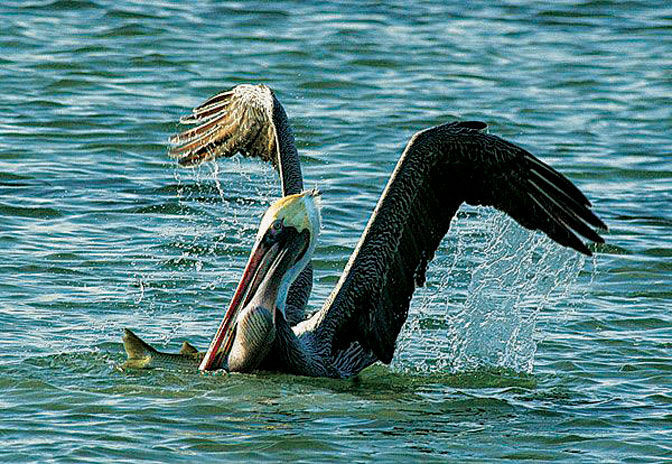More than 200 brown pelicans were rescued by volunteers along State Highway 48 Thursday, which was in stark contrast to a vehicular massacre of the birds one year ago.
The “Pelican Team” was created following two storm-filled days last December after cold fronts created conditions forcing pelicans onto the roadway that stretches from Port Isabel to Brownsville. Between 60 and 100 birds perished under the wheels of vehicles along a stretch of highway with a 75-mph speed limit.
This year between a dozen and two dozen birds were lost, but the numbers were far fewer due to the efforts of the Pelican Team as well as the Texas Department of Public Safety, U.S. Fish and Wildlife Service, Texas Parks and Wildlife Department, Texas General Land Office, Texas game wardens, Good Samaritans and the Port Isabel Volunteer Fire Department.
“Thinking back and talking with people today, I think we probably pulled off the road in total something around 150 birds,” said team member Justin LeClaire, a wildlife biologist. “I know I personally grabbed and moved across the road 24 by myself and there were 10 of us out there.”
Other pelicans were flushed from the roadway to safety.
“There’s no doubt in my mind we saved at least 200 pelicans yesterday,” he added.
LeClaire said team members began operating about 2 p.m. Thursday when pelicans trying to escape the high winds from the strong cold front began dropping on State Highway 48 as they attempted to fly from the Brownsville Ship Channel into the Bahia Grande Unit of Laguna Atascosa National Wildlife Refuge.
Due to how the roadway is constructed, particularly the barriers on both sides of Highway 48 and the center divider, when the wind is just right out of the north or northwest it creates conditions that push flying pelicans down onto the roadway.
The barriers intensify high winds on the sides but leave a dead zone over the roadway which causes pelicans to flop onto the asphalt where they are vulnerable to vehicles.
“Winds are hitting the barriers and the causeway in general and being forced up over it, and when they’re forced up it really speeds up the wind,” LeClaire said. “In that first lane … there’s this void of air, there’s no air flow going on there. But above it is this increased wind speed.
“The pelicans are flying low down the Gayman Channel from the Ship Channel trying to get into Bahia and they go up and just don’t have enough air going over the road,” he added. “They hit that super-fast wind and they basically stop and slowly cruise downward and they get so low it seems like they hit that pocket of dead air and they just don’t know how to handle it and they just fall out of the air from about five feet up.”
TxDOT has studied the barriers and the effect they have on flying pelicans using a wind tunnel to simulate conditions like those that occurred Thursday afternoon between 2 p.m. and dusk. TxDOT workers also put out flashing signs warning motorists of the pelicans on the roadway and urging them to slow down.
“TxDOT has basically now determined that the barrier is the issue, and they’re contracting for the next phase of this study,” said Nicole Ekstrom, president of Friends of the Laguna Atascosa National Wildlife Refuge and an organizer of the Pelican Team although she wasn’t out on the highway Thursday. “They need more studies so that they can determine which kind of configuration would work.
“TxDOT is all about the safety of motorists so they can’t remove the outside barriers or you’d fly off the bridge and they can’t remove the middle barrier because of potential head-on collisions,” added Ekstrom, who also is a wildlife biologist.
Safety of human volunteers was at the forefront of Thursday’s action, with four DPS cruisers and three game wardens all with their vehicle lights flashing — and the Port Isabel Volunteer Fire Department.
Fire Marshal John Sandoval said his department responded to a request from the Cameron County Office of Emergency Management and sent a rescue truck and a command vehicle out late in the day to the Highway 48 site.
As the Pelican Team disbanded because of the danger from traffic in the unlit area after dark, Port Isabel firefighters took the next shift.
“We were trying to slow down traffic,” Sandoval said yesterday. “In previous years, it’s been a complete slaughter out there but I think we did a pretty good job of getting most of them out of the roadway.”
Sandoval said it appeared the conditions that cause the pelican deaths were moderating yesterday afternoon but his department was assessing the situation and would respond again if needed.
Pelicans, alas, show little appreciation in being rescued.
The birds, understandably disturbed by their flight difficulties over the highway, sometimes regurgitate fishy oil all over the rescuers.
Some injured birds were taken to the Gladys Porter Zoo in Brownsville for treatment.
By RICK KELLEY Staff Writer





